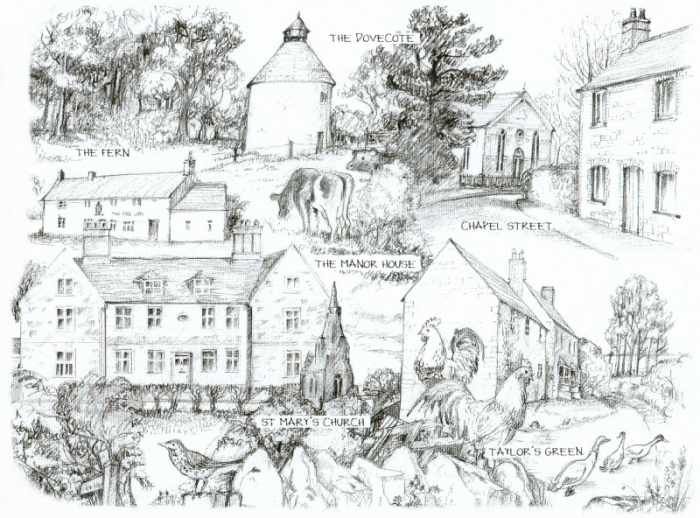This is a part of a drawing of the village by Chris Ellard, produced for the millennium celebrations, which now forms the centre of the village Interpretation Panel in Church Lane. It shows a few of the many places of interest in the village.

Overview
Warmington can trace its origins back to the 7th century when the King of Mercia granted the land to the Abbey of Peterborough. A charter of Edgar in 963 also names Warmington among the estates of the monks of the Abbey of Peterborough. Warmington is listed in the Doomsday Book as a part of the land of Peterborough Abbey. It is described as having 71/2 hides. Land for 16 ploughes. A mill, 40 acres of meadow and 1 acre of woodland. There were also 13 villagers, three freemen and two small holdings.
The village is also located on the route of a Roman Road running from Elton to Barnwell.
- The Fern is an area of woodland named on a 17th century map of the area. It runs alongside the west side of the footpath from Warmington to Elton.
- The Dovecote is of mixed age. The lower part dates from the 14 or 15th century. The top was rebuilt in the 16th or 17th century. Further rebuilding took place around 200 years ago. It contained 797 wooden nesting boxes and a rotating frame to give access to the nests. It is located in Eaglethorpe on the Northwest edge of the village.
- The Methodist Chapel was built in 1881. It is now a private home.
- The Red Lion Pub dates from the early 1800s. The toilet block was once the village fish and chip shop.
- The Manor House dates from 16th and early 17th century and was built by the Elmes family.
- The Church of St Marys is 12th century and considered to be one of the best examples of a rural parochial church of this
style and period. - Taylors Green runs along the southern edge of the village. Immediately to the south of the road was the hamlet of Southorpe. The hamlet is shown on an enclosure map of 1775 but not on a latter map of 1889.
- Other places of interest in the village include, the Oast House, The Mill, the moat, the water meadows, protected wild flower verges, a WW2 pill box and the two Pocket Parks.
